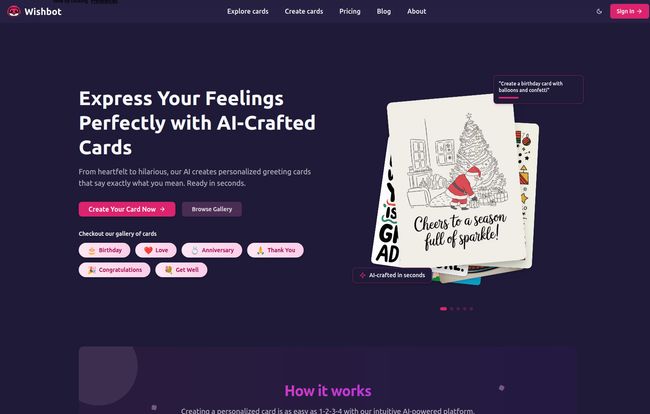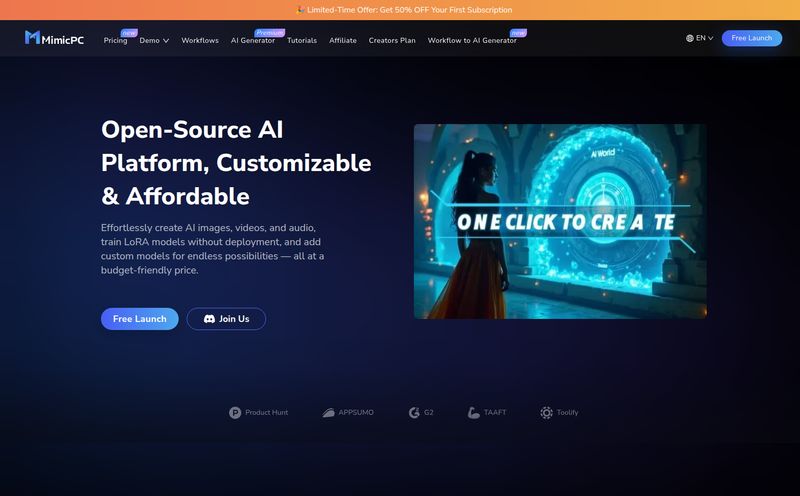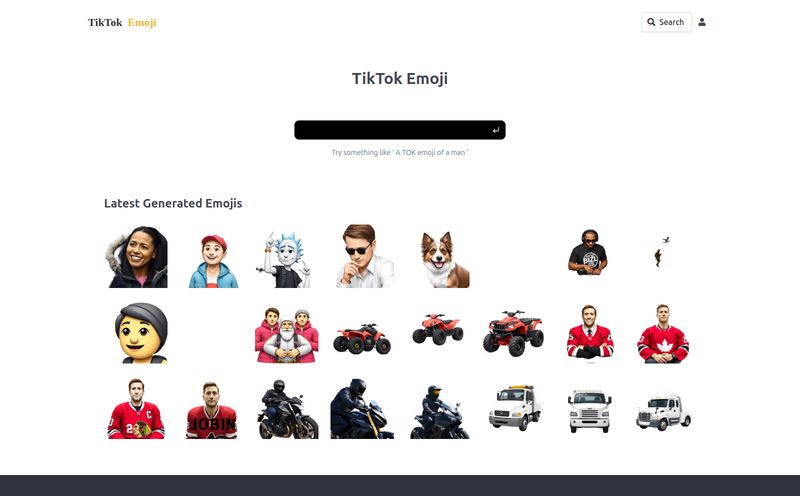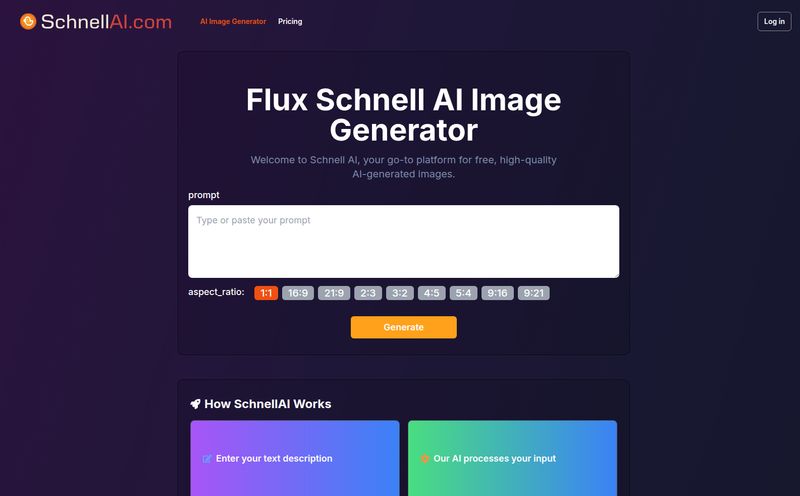It’s 10 PM. And you’ve just realised. It’s your best friend’s birthday tomorrow. Panic sets in. The nearest card shop closed hours ago, and let's be honest, the selection at the 24-hour convenience store is… grim. We've all been there, right? Scrambling for a card that doesn't scream "I completely forgot about you until my phone reminded me."
For years, the solution has been ecards. But they always felt a bit… cheap. Impersonal. Like sending a digital flyer. But what if AI could change that? What if a machine could help you create something genuinely personal, funny, and specific in seconds? That’s the promise of tools like Wishbot, and as someone who’s spent way too much time staring at racks of generic greeting cards, I had to see if it lived up to the hype.
So, What on Earth is Wishbot?
At its core, Wishbot is an AI-powered platform for creating and sending personalized greeting cards. Think of it as a mash-up between a traditional ecard site and an AI image generator like Midjourney, but laser-focused on one thing: helping you express yourself. It’s designed to be fast, easy, and a whole lot more creative than picking from a static library of pre-made designs (though it has those too, if you're in a real hurry).
The main attraction is the AI generator. You feed it a prompt—a description of what you want—and it spits out a unique card design. A cat DJing a birthday party? A sad-looking avocado apologising for being late? The possibilities are pretty much endless, which is where the magic really happens.

Visit WishBot
Putting the AI to the Test: My First Card Creation
Okay, theory is great, but I wanted to get my hands dirty. The site claims creating a card is as easy as 1-2-3-4. Skeptical, but I dove in.
The process is genuinely straightforward. You just type a description of the card you envision into a text box. For my test, I wanted something for a friend who's obsessed with gardening and fantasy novels. I typed in:
A happy gnome with a pointy red hat, watering a glowing mushroom in an enchanted forest, birthday theme.
I hit 'Generate'. And I waited. For about… 15 seconds. What came back was surprisingly charming. It wasn’t just a stock image; it was a completely new piece of art that perfectly matched my weirdly specific request. From there, I could customize the text inside, change the fonts, and boom. Card ready to send. The whole thing took maybe two minutes, and most of that was me trying to think of a witty message.
It felt less like designing a card and more like having a tiny, on-demand illustrator living in my browser. It’s fast, its fun, and the result is something you absolutely couldn't find in a store.
The Good, The Bad, and The AI-Generated
No tool is perfect, of course. After playing around with Wishbot for a while, a clearer picture emerged of its strengths and weaknesses.
A Spark of Genuine Creativity (No Art Degree Needed)
This is Wishbot’s biggest win. You can create cards for inside jokes that only you and the recipient would understand. My friend who loves trashy reality TV and llamas? I can make a card for that. The ability to generate something so specific makes the end product feel incredibly thoughtful. It bypasses the whole "I spent hours looking for the perfect card" by letting you create the perfect card in minutes. It’s a powerful way to show someone you get them, and you dont need an ounce of artistic talent to do it.
The Eco-Friendly and Budget-Conscious Angle
Let's not forget the practical side. These are digital cards. No trees are harmed, no fuel is spent on delivery, and no old cards end up in a landfill. It's a small thing, but it adds up. Plus, the platform is genuinely budget-friendly to start. The free plan gives you 10 AI credits, which means you can send 10 AI-generated cards without paying a dime. For the average person who sends a handful of cards a year, that’s a pretty sweet deal.
Let's Talk About the Downsides
Now for the not-so-great stuff. The first thing that gave me pause is that all AI-generated cards are public. This means that super-personal, heartfelt card you made for your anniversary might pop up in the public gallery for others to see and use. For a casual birthday wish, who cares? But for something more private or intimate, that could be a deal-breaker. I'd love to see a 'private generation' option in the future.
The second catch is with the subscription model. If you pay for a plan, your unused monthly AI credits expire. They don't roll over. It’s the classic “use it or lose it” approach, which always feels a little bit frustrating. It's like a gym membership for your sentimentality; if you don't feel like being thoughtful for a month, you're still paying for it.
The All-Important Question: What's the Price?
So, what does this actually cost? The pricing structure is pretty simple, which I appreciate.
- Free Plan: You get 10 AI credits right off the bat. One credit equals one AI card generation. This is more than enough to try the service out and handle a few birthdays or holidays.
- Subscription Plan: For $29.99 per month, you get 200 AI credits.
My take? The free plan is fantastic. But that subscription price... it feels a bit steep for an individual. Who needs to send 200 personalized AI cards a month? I could see this making sense for a small business, maybe a realtor or a consultant who wants to send unique, personalized thank-you or holiday cards to their entire client list. For that use case, the price could easily be justified. For the average Joe, though, sticking to the free plan or buying smaller credit packs (if they ever offer them) seems like the way to go.
Is This the Future of Greeting Cards?
Here’s the thing. I'm a bit old school. I love the feel of a physical, handwritten card. Some might argue that a digital card, no matter how personalized, can't replace that.
And maybe they’re right. But I'll argue this: a highly personalized, thoughtful, and funny AI-generated card that took you two minutes to create because you were thinking specifically of that person is infinitely better than a generic store-bought card you grabbed out of obligation. The effort isn't in the medium; it's in the thought. Wishbot just makes executing that thought incredibly efficient.
It's not about replacing tradition entirely. It's about having a better option for the moments when tradition isn't practical. It's a fantastic tool for bridging the gap between a low-effort text message and a high-effort trip to the post office.
Final Thoughts on Wishbot
So, does Wishbot deliver on its promise? Yeah, I think it does. It's a genuinely innovative and fun tool that solves a real, albeit minor, problem in our lives. It’s fast, the creativity is basically limitless, and the free offering is generous enough for most people.
The public nature of the cards and the subscription model are definite drawbacks to keep in mind, but they don't overshadow the core value. If you've ever found yourself in a late-night panic for a card, or if you just want to send a friend a picture of a cyborg squirrel wishing them a happy Tuesday, you should absolutely give Wishbot a try. It might just surprise you.
Frequently Asked Questions About Wishbot
- 1. Are the cards on Wishbot really free to make?
- Yes and no. You get 10 free AI credits when you sign up, which lets you create 10 unique AI-generated cards. There are also pre-made cards you can send for free. If you need more than 10 AI cards, you'll need to look at their paid subscription.
- 2. Can I make my AI-generated cards private?
- Unfortunately, not at this time. According to their model, all cards generated by the AI are public and may appear in the main gallery for others to use. This is a key consideration for highly personal messages.
- 3. What happens to my unused credits if I have a subscription?
- On the monthly subscription plan, any unused AI credits expire at the end of the month. They do not roll over to the next month.
- 4. How does the AI actually create the card image?
- While Wishbot doesn't specify the exact model, it works like most modern text-to-image AI. You provide a text prompt, and the AI interprets your words to generate a completely new image based on its training data.
- 5. Is Wishbot a good tool for businesses?
- It certainly could be. For a small business wanting to send personalized holiday cards, thank you notes, or promotional messages to clients, the subscription plan for 200 cards a month could be a cost-effective and unique marketing tool.
- 6. Is an AI card better than a traditional ecard?
- I'd say so. A traditional ecard is a static template that thousands of others have sent. A Wishbot card can be generated from a prompt that is completely unique to your recipient and your relationship with them, making it feel far more personal.



